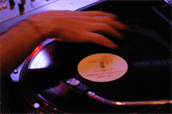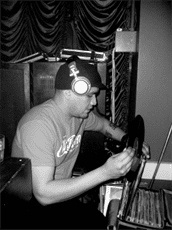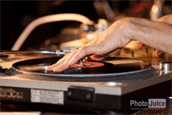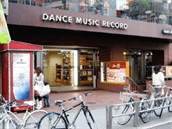Learning to DJ with Vinyl and why you could consider it
Wednesday, February 10, 2016
by Tat
Before we start let's make one thing clear that this is not another article on whether vinyl is better than digital or the other way round. This topic has been covered on multiple occasions that have gone as far as discussing the actual scientific data beyond opinion and subjecture. We can safely say that this conversation can be filed into the same fusty location of PC vs Mac and digital vs analogue music making - we all can agree to disagree.
We thought it would be interesting to discuss whether there are merits on learning how to DJ on vinyl rather than digital, or even CDs. This is purely hypothetical and tries to discuss whether given the option as a DJ starting out why vinyl would be a good, not better option. There are many practical pros and cons as to why DJs would choose digital over vinyl. Firstly the music is cheaper, you can buy individual tracks rather than a whole ep with just one killer tune on it, it is easy to transport as there is no need to break your back carrying heavy vinyl around with you. There is also the issue of storage and for some DJs the thought of trying to navigate their collection across multiple rooms.
When vinyl was the only way
The guys at Trackhunter all learned to DJ with vinyl as far back in the late 80s there was no other option. In fact I learned to DJ on belt driven decks and even scratch on an old hifi in 1987. Yet at no point am I saying that this is the true way, it is just another way, we have many options these days and choice is good as long as you don't have too much of it. So for those thinking this is just another piece about only true DJs use vinyl, think again. Whilst technology is ever changing even back in the day there were issues. In a recent article on Pitchfork about old DJs including Bobby Viteritti. The disco veteran talked about how he can't play like he did when he was 28 because he had vinyl then and now has Serato and Traktor. Viteritti said: "MP3s are a pain in the ass to work with, you don't have the same control like you did over records. In the old days, we used to have rotary knobs. Now everything's a slider." Of course there are many older DJs who did make the leap to digital and haven't looked back.
The learning curve
As with anything that involves a digital iteration of an analogue system it often aims to flatten out the earlier steeper learning curve. The whole point of technology advancement is to make lives and tasks easier. Computers have become smarter and require far less setting up, music production is simpler, for example samplers have more power and are easier to use than they were 20 years ago. The basics of DJing remains the same, what has changed is the ability to manipulate the tracks and perform live remixes on the fly. Speak to any DJ who learned their skill on vinyl and they will tell you that there was a learning curve involved. I've known DJs who have taken years to perfect their mixing and scratching skills. Of course there is always the exception to the rule and some who learn these skills in days. The learning curve with digital DJing is far less steeper if we are talking about the core skills of mixing. Of course I can only go on my own experiences and one such experience was the first time a friend let me have a go on his copy of the first Traktor software. I went through his folders and was able to mix three tracks seamlessly without headphones for four minutes without any manipulation. Added to this was that I had never heard these tracks before. What has changed with digital DJing above anything else is the ability to craft clever and inventive mixes and remix them using a myriad of tools and tricks.
The learning curve is important in any artistry, that to master the basics of any skills is good, but there is always a temptation to rest on your laurels. A learning curve gives you time to think and create your own style, the best way to learn is by trial and error. Making mistakes results in two outcomes, you either give up or you try and try again. Each time you try you adapt and change and in time hone your skills. Again I am in no way implying that digital DJing is easier, it isn't as long as you explore the functionality of the software and interfaces. In fact digital djing using every bit of the functionality can be quite complex, far more complex than traditional vinyl.
Looking for the perfect beat
The art of track selection has always been one of the biggest skills a DJ can have, with some signing up to the adage "selection trumps the mix". With USB sticks and laptops DJs can have a wealth of tracks at their disposal and that can be great when keeping a crowd entertained. It might be no coincidence that the posturing, arms in the air superstar DJ came about as they no longer had to spend all their spare time between mixes on their knees in the dark seeking out the next track from their record box. Of course this started with vinyl and the likes of Fatboy Slim but as talented as he was, his sets were not mixed in the style most modern house DJs perform. Anyone who has ever experienced the anxiety of rifling through records to find a track you knew you had packed but could not find will know it's not a great feeling. Yet for the most part that time was valuable, as it made DJs think on their feet and more importantly keep them away from a set list. Sure they have a set of records, as you would on a USB stick, but with digital the temptation is to mix them in the order you have compiled - rarely did DJs ever move through their record box in strict chronological order. Of course digital means that mixes can be honed and replayed again and again, it makes life very easy for the busy travelling DJ. If a set list works in one club, then it could do in the next, and that is fine. There have been many debates on the issue of DJs playing ready sequenced mixes and whether that is acceptable. You will be hard pushed to find many making a living who would confess to delivering a premixed set as standard.
Even with digital, old habits die hard, as there have always been DJs who work to strict track list. The time spent flicking through your record box gives a DJ time to think about what options they have, where they can take a mix and keeps them focused on the job in hand. The problem with a preset mix list is that if it is poorly received on the dancefloor that it could leave them struggling to switch from the linear set. The temptation with digital DJing is that you work to lists and sets, it can be very easy to keep tracks matched by their BPM. This is often why you hear many mixes that remain consistent in their pitch and momentum. Of course there is nothing wrong with maintaining a certain BPM, it is dance music after all. The problem is that it can become a crutch and sets could become predictable and staid. Potentially by learning by vinyl you can bring in a level of eclecticness and uncertainty. Some of the world's legendary DJs have brought an element of edge to their sets that you can never tell where their set is going. This is possible with digital of course.
The touch and feel of vinyl
Being able to manipulate music by touch will always win hands down over a laptop trackpad and keyboard. The same applies for CDJs, that is, you are able to interact with a device so you can manipulate the mix better than just using waveforms. The advantage of vinyl or CDs is that "on the fly element" that you can decide when and where you drop a track quicker and easier than mixing software. Of course that is not true for everyone, but you potentially are more likely to skip through the audio for drops and cues than looking for more obvious spikes in a waveform. You can put in cue points and drop tracks when you want in something like Traktor but for many DJs this can be premeditated. With vinyl you can learn the flexibility to play tracks at different points on the fly, if you know a track has a breakdown you can often access it quicker on a record or time code vinyl than scrolling a waveform. Scratch DJs and some dance DJs did this by placing tape on the vinyl, although it was never a great idea if you wanted cherish and look after your plastic. Of course with digital DJing you have a vinyl mode with Serato and Traktor, which does as it says on the tin, in that it gives DJs the option to manipulate their set like a vinyl DJ. The option of manipulating vinyl has not been created through nostalgia, but because as an interface it works - it just comes with a whole different set of limitations. It does offer the best of both worlds, especially for any digital DJ with a vinyl back catalogue. I know a few DJs who despite having hefty vinyl collections have moved purely to this format. Whilst if a track has an acapella or sample you can work from, then again it becomes easier to drop it into a track manually than via a button. Again everything is possible with digital, it does everything vinyl does but by learning these skills on vinyl you are open to to options on where you start and finish a mix on the fly.
Scratching
A technique that has been monopolised by hip hop but there have been moments and DJs who have brought it into the techno, breakbeat, house and drum & bass arenas. The rave and early jungle scenes embraced the ability to scratch whilst it seems to have returned to being a mostly hip hop tool. So why is that? I would argue that it is because hip hop DJs regardless of being digital or analogue still use turntables. Yet even basic scratching is not hard to learn, it just takes practice and an interface to carry it out. You can scratch with controllers, laptops and CDs but it will never be as good as a turntable. The larger the area of manipulation - i.e. the turntable platter - the easier it is to manipulate as your arm is free to move in synch with the fader and the sound. Digital does seem to have restricted scratching outside of hip hop, not killed it, as an option for non-hip hop DJs as so many no longer use a turntable. Scratching is just another weapon in the DJ arsenal regardless of whether you play house or techno. In fact it is even more possible given that many mixers and interfaces now have fx buttons meaning you do not even need to be that skillful with a scratch to make it enhance your mix.
Record shops and networks
Finally for those DJs living in towns and cities that have record shops it can be a good way of making contacts and even finding work. Most record shops that stock dance music are usually friendly, gone are the days when the moody record shop staff ruled the roost. Spending time in a record shop can be useful as you get to hear the recommendations of the staff who are usually very knowledgeable and in touch with the latest releases. They also usually know what is happening in the local scene and can be a good point of contact for anyone running a night or looking for gigs. There is also the bonus that they can introduce newer DJs to back catalogues and classic tracks that they may miss by just using the web. Again many DJs do very well just using the web, hence the development of Trackhunter which helps sort the wheat from the chaff. Yet it is good to have as many options as possible when trying to find the best tracks for your sets.
Vinyl is not king, just an alternative
The point of this blog post is not about saying vinyl is better, but there is much merit in being able to DJ on both vinyl and digital. Using either is fine, it really comes down to your own personal tastes and what you do with your DJing. If you are just playing in your bedroom with a limited budget or out four nights a week then digitial will serve you well, but if you fall somewhere in between then you might consider exploring both. If you are just starting out as a DJ and unsure where you start then at least with tools like Traktor and Serato you have the option of using all formats.
Try Trackhunter on Mac or Windows right now for free








